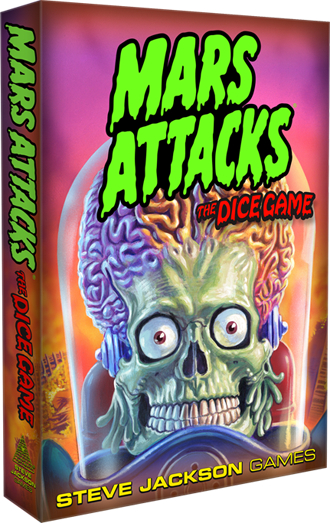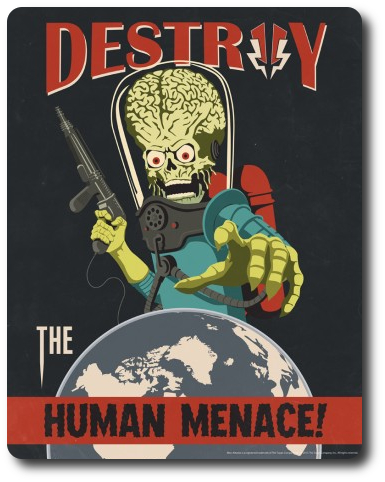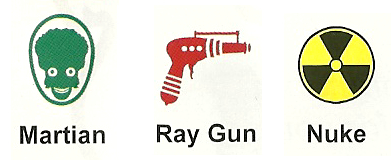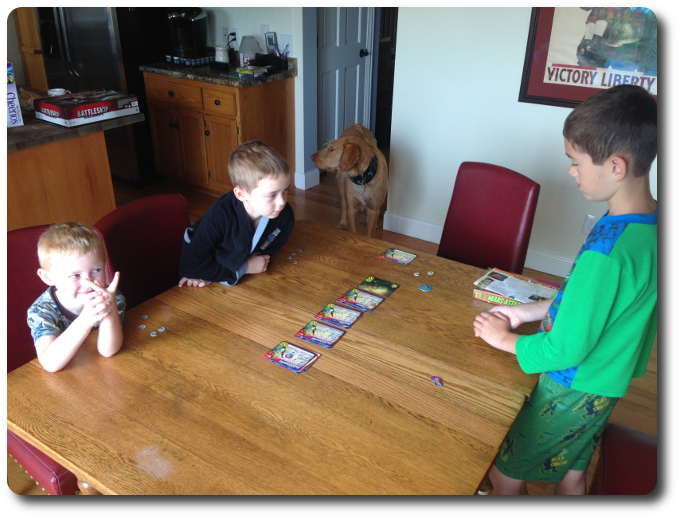
The Basics:
- For ages 4 and up (publisher suggests 10+)
- For 3 to 6 players
- Approximately 20 minutes to complete
Geek Skills:
- Counting & Math
- Logical & Critical Decision Making
- Reading
- Pattern Matching
- Risk vs. Reward
- Hand/Resource Management
Learning Curve:
- Child – Easy
- Adult – Easy
Theme & Narrative:
- Destroy the humans!
Endorsements:
- Gamer Geek mixed!
- Parent Geek approved!
- Child Geek approved!
Overview
We have looked up at the stars for generations wondering what awaited us in the vacuum of space. We have sent satellites and radio signals into the blackness in hopes that someone would respond. When someone did, we were overjoyed and our leaders made plans. We now stand ready to embark on a great adventure! Our mission is clear: Conquer Earth!
Mars Attacks: The Dice Game, designed by Sam Mitschke and Philip Reed and published by Steve Jackson Games, is comprised of 10 custom six-sided dice, 29 Location cards, 1 Difficulty card, 24 Player tokens (in 6 different colors, 4 tokens per player), and 1 First-Player token. The tokens are solid cardboard and very durable. The Location cards are about as thick as your standard playing card. The dice are plastic with etched colored symbols.
Note: The artwork on the game box’s front, back, and Location cards depicts some creepy looking aliens. Some of our younger Child Geeks thought it was too creepy and some of our Parent Geeks shied away from the game due to the artwork, as well. The artwork in question is taken from the Mars Attacks! trading cards released by Topps in 1962. If you are not familiar with the trading cards (which are a cult classic, by the way), you might be familiar with the less impressive Mars Attacks! film by Tim Burton.

Image taken from Topps.com. All rights reserved.
Prepare for the Invasion
To set up the game, first give each player 4 Player tokens each of the same color. Any Player tokens not selected are returned to the game box.
Second, find the Difficulty card and determine, as a group, the level of difficulty for the game. The Difficulty card is double-sided with one side showing a single “Nuke” symbol and the other side showing two “Nuke” symbols. For an easier game, select the side with two “Nuke” symbols. For a more difficult game, select the side with one “Nuke” symbol. Place the selected difficulty face-up on the table.
Third, shuffle the Location cards and deal out 4 piles, face-down. The number of cards in each pile should equal the number of players. For example, a 6-player game will have 4 piles of Location cards consisting of 6 cards each. Place the face-down Location cards and the Difficulty card in a row. Flip over the top card of each Location and orientate the cards so the “Nuke” symbols are aligned in a single column. Any Location cards not dealt are returned to the game box.

Fourth, determine who the first player is and give them the dice and the First-Player token. Time to conquer Earth!
Crushing Humanity
Mars Attacks is played in rounds with no set number of rounds per game. On a player’s turn, they will be able to take several actions. Some actions are taken by choice while others are forced upon the player. A typical player’s turn is summarized here.
Step 1: Check for Special Rules
As the game progresses, players will conquer Location cards that include new rules in the game. The player should quickly check to determine if any special rules apply to them before proceeding.
Step 2: Declare Target
There are two types of Location cards. These are “City” and “Monuments”. The only Location cards the player can declare as a target (i.e. the location they are invading) are the Location cards that are currently face-up on the 4 Location card stacks. Note that a player might have already declared and attacked multiple locations during their previous turns. If the player so chooses, they can return to attack the same Location again or attack a new location. Locations attacked by opponents can be attacked by the player.
Step 3: Attack!
After the player has declared their target, they take the dice and roll all of them. Depending on the Location they are attacking and the dice symbols rolled, the following occurs.

- If attacking a “Monument” Location, all “Martian” symbols are set aside on the “Monument” Location card and go towards the total number of invading army soldiers needed to take over the monument.
- If attacking a “City” Location, all “Ray Gun” symbols are set aside on the “City” Location card and go towards the total number of razed buildings needed to claim the card.
- If a “Nuke” symbol is rolled, it’s set aside and placed on any unoccupied “Nuke” symbol located on a Location card or the Difficulty card.
The player MUST roll once on their turn. After that, they need to make a choice. They can either keep rolling or decide to stop. If they decide to stop, the total number of dice rolled that match the symbol needed to conquer the Location the player targeted this turn is recorded. This is done by taking the Player token and placing it on the Location card. Each Location card lists the total number and type of symbol necessary to conquer it. The player places their Player token on the correct number. If they previously visited this location, they add their latest roll to any previous rolls. In this way, the player takes over Location cards over several turns.
If the player chooses to continue to attack, they take the dice that were not set aside and roll them again. They then place the dice according to their rolled value. The player can stop at anytime during their turn or keep going until they are forced to end their turn.
Location Conquered!
If the player is able to roll the number of correct dice necessary to conquer the Location, the player claims it and will be awarded the victory points listed at the end of the game. All Player tokens are removed and returned to their owning player. Collected Location cards should remain face-up so as to allow all players to see victory points collected. The topmost Location card of that stack is then flipped over to reveal the new location. This ends the player’s turn.
Humans Fight Back!
If the player rolls and covers all the “Nuke” symbols on the Location and Difficulty cards, their attack wave has been obliterated! All dice results for the players turn are now null and void, but dice rolls in previous turns remain valid. The player’s turn is now over. Note that a few Location cards have “Nuke” symbols that must be rolled to conquer it. These do not count towards the total number of “Nuke” symbols that end the player’s turn.
Location Special Rules
Some Location cards have special rules that come into play when they are conquered. There are two types.
Red Special Rules
The red special rules are active for all the players for as long as the Location card is in play (i.e. face-up but not conquered). However, each special rule has conditions that must be met before they can be triggered. The player should check during step 1 if any of the Location cards have a condition that effects them during their turn.

Green Special Rules
The green special rules only apply to the player who conquered the location. The effects of the Location card remain in play for the duration of the game.

Ending the War
The endgame is triggered when the last card from any of the Location card piles as been conquered. The game continues until it is the First-Player’s turn. The First-Player does not get to take a turn. All the players now determine their score by adding the victory points earned from their conquered locations. The player with the highest score wins the game and Earth. Ties are broken by total number of Locations conquered.
To learn more about Mars Attacks: The Dice Game, visit the game’s official web page.
Prediction
Games like Mars Attacks have been warmly received by the Child Geeks, enjoyed by the Parent Geeks (especially the non-gamers), and oftentimes rejected by the Gamer Geek elitists. But not always. We’ve reviewed other press-your-luck Dice games like Zombie Dice, Martian Dice, Trophy Buck, Zogar’s Gaze, and Grablin, so predicting Mars Attacks isn’t going to be difficult.
The Child Geeks are going to love it, the Parent Geeks are going to like it, and the Gamer Geeks are going to tolerate it.
There is enough of a game here for everyone to sit down and enjoy on different levels. Its lack of depth, however, is going to disappoint the Gamer Geeks. For the Parent Geeks, the race to collect locations and the ability to save progress should make them feel a bit more invested in their rolls and decision making. For the Child Geeks, all that is necessary is the “idea” that they are destroying Earth and they’ll be loving it.
Teaching Mars Attacks is best done by taking a card, rolling the dice, and placing them. Explain what each symbol means, how it’s used, and how things can go wrong if the player presses their luck too much. Make mention of the special rules, as well. But above all else, make sure the players understand the game comes to an end when the final card in a stack is removed. NOT when all the cards are claimed.
Note that this game does require a bit of reading, but any player can read the card out loud to younger players who cannot read yet. There is no hidden information in the game. All that is necessary to play is the ability to match symbols on the cards to the dice rolled and understanding risk vs. reward. In short, this game should be playable by very young little geeks.
And so, after teaching Mars Attacks to my 3 little geeks, I asked them their thoughts on the game so far.
“Really great artwork. I like that we are blowing up different locations around the world. But where is Minneapolis?” ~ Liam (age 9)
“When I attack, I’m going to go PEW PEW!” ~ Nyhus (age 7)
“I’m going to capture everyone, but save Mommy.” ~ Ronan (age 4)
Time to conquer Earth! Let’s see if Mars Attacks is an explosive good time or an intergalactic letdown.
Final Word
The Child Geeks had a blast with Mars Attacks. All ages demonstrated a clear understanding of the dice and how they were to be placed. The younger Child Geeks didn’t do so well when it came to holding back their attacks and preferred to press their luck to a point where they almost always nuked themselves. Not that it mattered, since they were laughing the whole time. The older Child Geeks did understand the risk vs. reward aspect of the game and did a great job of slowly taking over large locations for big points. According to one Child Geek, “I really like this game. What I like the most is that I get to change my attacks each turn.” Another Child Geek said, “I want to play this again as soon as we are done destroying everything.” When all the games were over and Earth was fully conquered, the Child Geeks voted to approve Mars Attacks.

My three little Martians eagerly destroy Earth
Some of the Parent Geeks were not fans of the box artwork and didn’t want to play the game because of it. When I showed them the components, they were willing to give the game a shot. It should be noted – again – that the artwork can be a bit alarming if you are a squeamish kind of person, but the game play has none of the violence depicted on the box and cards. This is a simple roll and place dice game. Once the Parent Geeks saw this, they were ready to give Mars Attacks a try. When they did, they found the game to be fast, fun, and light. Everything most casual and non-gamer Parent Geeks want in a game. According to one Parent Geek, “This is a game I can play with my kids and friends pretty easily without a lot of explanation. I like that.” Another Parent Geek said, “It’s uncanny how often the nuke shows up just when you don’t need it.” Indeed. When all the Parent Geeks were done with their games, they voted to approve Mars Attacks.
The Gamer Geeks played the game and appeared to have a good time. When I asked for feedback, I was surprised that a few of them found the game to be boring. When I pressed for details, one Gamer Geek said, “All I am doing is rolling dice and placing them. It’s an OK game to play once, but not twice.” Another Gamer Geek jumped to the game’s defense and said, “Let’s not forget that this is a game designed to be light, fast, and fairly shallow as far as strategy and tactics go. This game delivers what it was designed to do. I liked it.” The big sticking point that tended to divide the Gamer Geeks was the repetitive nature of the game itself. The special rules improved the game a bit, but not enough to be of any value to the gaming elitists. In the end, the Gamer Geeks all agreed that Mars Attacks was a good game for quick plays, quick fillers, and whenever you just wanted to roll dice. However, they could not decide if the game was worth a Gamer Geek’s time, resulting in a mixed approval.
Once aspect of this game I didn’t care for was the way it can quickly snowball. Depending on how the Location cards are randomly dealt, a player could get a number of quick points and dig through the stacks of Location cards to end the game. That’s pretty irritating. My 9-year-old is notorious for doing this. He just focuses on one stack and completes it as soon as possible. He doesn’t get a lot of points, but he gets enough to win. Admittedly, this is a great strategy to win the game, but there is nothing in the rules that allows his opponents to stop him. The end result is a game that is just a quick dice roller.
Which is probably exactly what the game is meant to be, but I wanted it to be more. I was left feeling like the game had nothing to really do with Martians attacking cities and burning monuments to the ground under the brutal bombardment of laser fire. Instead, I felt like I was playing a race game where luck determined how far I could go. No strategy or tactics to be used to get the upper hand. Only logical thinking and cursing at the dice.
But I still had fun, despite my disappointment of not feeling like an intergalactic warlord commanding a giant army of Martian shock troopers. Mars Attacks is quick, it’s entertaining (to a point), and it most certainly is accessible to everyone. It’s a great game to bring out when you have a mixed group of friends who are and are not familiar with board or dice games. My kids love it and I love playing it with them. That’s as good as it gets from a Parent Geek’s perspective, but the Gamer Geek in me wanted more.
This game was given to Father Geek as a review copy. Father Geek was not paid, bribed, wined, dined, or threatened in vain hopes of influencing this review. Such is the statuesque and legendary integrity of Father Geek.




Pingback: Spotted Online – Mars Attacks Dice Game Review at Father Geek
Pingback: In Review: Father Geek’s Monthly Newsletter (August 2014) - Father Geek
Pingback: In Review: Father Geek’s Monthly Newsletter (September 2014) - Father Geek